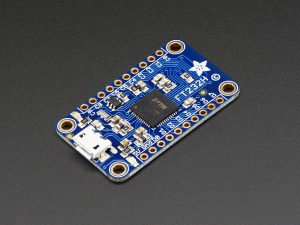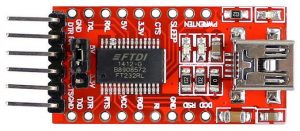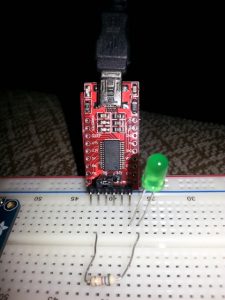During a discussion with my dad about doing GPIO style projects from a regular, full fat computer, I was telling him about the Adafruit FT232H Breakout board. These boards allow you to use several different serial protocols such as SPI, I2C and UART as well as provide a GPIO mode if you are willing to get involved enough. It provides an elegant solution to connecting external electronic devices, because it doesn’t require any software to be loaded into the device itself – all your code is running on your computer. The one downside is that, here in the UK at least, these boards cost in the region of £15, meaning that personally I would usually just grab a cheap Arduino and write some kind of pass-through program for most things I’d want to do.
Yesterday evening, I installed the various software identified in Adafruit’s “Learning System” page relating to the product to allow me to set up various pins as inputs and outputs from a python program, in a similar style to how you might use the GPIO pins on a Raspberry Pi. Looking at what I needed to install and the fact that you had to specifically tell some of the libraries what chip you were connecting got me thinking that perhaps some of the software tools would work more generally with FTDI chips. I knew it was possible to use FTDI chips such as the FT232RL (commonly used in USB to UART serial adapters) as external USB connected GPIO, but my previous investigations hadn’t found clear (and simple enough) instructions to get anywhere in the time I had available. Today I dug out a cheap FT232RL based board and decided to have a play. At £1.38 each, these boards don’t exactly break the bank, and I have a pile of them already. I also like that you can easily switch the voltage using the jumper on these boards.
The following instructions relate specifically to Linux (Ubuntu 17.10), but following the instructions given on the Adafruit website may get you up and running on Windows or MacOS. Hardware-wise, any sensible computer with USB, a USB cable (Type A to Mini-B), a breadboard, a run-of-the-mill LED, an appropriate current limiting resistor (I used a 560 Ω resistor, which should be fine in most cases) and a FT232RL based board similar to the one above. The circuit is as follows (note the +ve side of the LED is identified by the longer lead, and the -ve by a flat on the side of the lens) :
Following the Adafruit instructions for Linux, carefully enter the following commands in a terminal :
sudo apt-get update sudo apt-get install build-essential libusb-1.0-0-dev swig cmake python-dev libconfuse-dev libboost-all-dev wget http://www.intra2net.com/en/developer/libftdi/download/libftdi1-1.2.tar.bz2 tar xvf libftdi1-1.2.tar.bz2 cd libftdi1-1.2 mkdir build cd build cmake -DCMAKE_INSTALL_PREFIX="/usr/" -DPYTHON_INCLUDE_DIR="/usr/include/python2.7" -DPYTHON_LIBRARIES="/usr/lib/python2.7/" ../ make sudo make install
This installs the dependencies, fetches the source code for libftdi1, compiles it and finally installs it.
To test that everything installed correctly, launch the python interpreter by typing “python” (excluding quotes) at the command line and pressing enter, then type “import ftdi1” and press enter. If there are no errors, then it installed just fine. Exit the interpreter by typing “exit()” and pressing enter.
Now would probably be a good time to return to your home directory and perhaps create a folder for your python project. We’ll then create a new file called LEDBlink.py and open it in nano (a text editor) :
cd ~ mkdir ftdiGPIO cd ./ftdiGPIO/ nano ./LEDBlink.py
Once you have the empty file open in the window, enter the following python program (which is based on the code found here). Note you can copy and paste from here – but use the copy button in the top right of the code container to ensure consistent formatting :
#!/usr/bin/env python
import ftdi1 as ftdi
import time
ftdic = ftdi.new()
# try to list ftdi devices 0x6010 or 0x6001
ret, devlist = ftdi.usb_find_all( ftdic, 0x0403, 0x6010 )
if ret <= 0:
ret, devlist = ftdi.usb_find_all( ftdic, 0x0403, 0x6001)
# open usb
ret = ftdi.usb_open( ftdic, 0x0403, 0x6001 )
# bitbang
ret = ftdi.set_bitmode( ftdic, 0xff, ftdi.BITMODE_BITBANG )
for i in range( 64 ):
ftdi.write_data( ftdic, chr(0x02), 1)
time.sleep ( 0.5 )
ftdi.write_data( ftdic, chr(0x00), 1)
time.sleep ( 0.2 )
ftdi.disable_bitbang( ftdic )
# close usb
ret = ftdi.usb_close( ftdic )
print ('device closed')
ftdi.free( ftdic )
This is a basic program with no error checking – it assumes that a device of the correct type is connected an available. Note that it will probably need to be run as root to access the hardware. The program finds and connects to the FT232RL (assuming it is plugged in), then blinks the LED 64 times, being on for 0.5 seconds and off for 0.2 seconds each time. Once the code is entered, press ctrl-x, then “y” and finally enter to exit and save. Check that everything is wired up as follows :
If everything is OK, plug the USB into the computer and enter the following commands :
chmod +x ./LEDBlink.py sudo ./LEDBlink.py
The first command sets permissions to allow the python program to be executed, the second executes it. If all goes well you’ll be asked for your password and then the LED will start blinking.
If it doesn’t, then… erm… well it worked on my machine…
The following code does the same thing, but includes error checking. A lot of it!
#!/usr/bin/env python
import os
import sys
import ftdi1 as ftdi
import time
ftdic = ftdi.new()
if ftdic ==0:
print( 'new failed: %d', ret )
os._exit( 1 )
# try to list ftdi devices 0x6010 or 0x6001
ret, devlist = ftdi.usb_find_all( ftdic, 0x0403, 0x6010 )
if ret <= 0:
ret, devlist = ftdi.usb_find_all( ftdic, 0x0403, 0x6001)
if ret < 0:
print( 'ftdi_usb_find_all failed: %d (%s)' % ( ret, ftdi.get_error_string( ftdic ) ) )
os._exit( 1 )
print( 'Number of FTDI devices found: %d\n' % ret )
curnode = devlist
i = 0
while( curnode != None ):
ret, manufacturer, description, serial = ftdi.usb_get_strings( ftdic, curnode.dev )
if ret < 0:
print( 'ftdi_usb_get_strings failed: %d (%s)' % ( ret, ftdi.get_error_string( ftdic ) ) )
os._exit( 1 )
print( 'Device #%d: manufacturer="%s" description="%s" serial="%s"\n' % ( i, manufacturer, description, serial ) )
curnode = curnode.next
i += 1
# open usb
ret = ftdi.usb_open( ftdic, 0x0403, 0x6001 )
if ret < 0:
print( 'unable to open ftdi device: %d (%s)' % ( ret, ftdi.get_error_string( ftdic ) ) )
os._exit( 1 )
# bitbang
ret = ftdi.set_bitmode( ftdic, 0xff, ftdi.BITMODE_BITBANG )
if ret < 0:
print( 'Cannot enable bitbang' )
os._exit( 1 )
for i in range( 64 ):
#val = 2**i
#print( 'enabling bit #%d (0x%02x)' % (i, val) )
#ftdi.write_data( ftdic, chr(val), 1 )
#time.sleep ( 1 )
ftdi.write_data( ftdic, chr(0x02), 1)
time.sleep ( 0.5 )
ftdi.write_data( ftdic, chr(0x00), 1)
time.sleep ( 0.2 )
ftdi.disable_bitbang( ftdic )
print( '' )
# close usb
ret = ftdi.usb_close( ftdic )
if ret < 0:
print( 'unable to close ftdi device: %d (%s)' % ( ret, ftdi.get_error_string( ftdic ) ) )
os._exit( 1 )
print ('device closed')
ftdi.free( ftdic )
Line 51 turns on the LED connected to the RX pin on my board which is the second pin out of 8. Pins are defined as follows :
Pin #0 = 0x01 Pin #1 = 0x02 Pin #2 = 0x04 Pin #3 = 0x08 Pin #4 = 0x10 Pin #5 = 0x20 Pin #6 = 0x40 Pin #7 = 0x80
Obviously these are binary sequence in Hex, meaning each bit represents a pin. To turn on multiple pins at once, just add the values together. 0x00 on line 53 turns all pins off.
The example code I previously mentioned was the basis of this program also contains a commented out section showing how to use pins as inputs. It is commented out because it doesn’t work with Python 3, but should work fine under Python 2.x.
UPDATE…
I’ve discovered that SainSmart produce relay boards that work in a similar way to this. Building on the above, I have produced a new post showing how to use these with Python on Linux.



